Sourdough Starter Recipe (Levain)
Published May 17, 2019. This post may contain affiliate links. Please read my disclosure policy.
If you’re serious about bread baking then learn how to make it as it was intended by making this sourdough starter recipe which is a natural levain to help your bread rise.
Making bread is a labor of love, and the process has definitely changed in the last 50-75 years. Gone are the days of making a natural yeast starter as commercial yeasts have completely taken over. While there is nothing wrong with using commercial yeasts, it has altered how we consume and digest bread.
If you have reactions to gluten in bread, it’s most likely caused by the lack of natural fermentation which should take place in bread baking. The natural probiotics that are formed during this fermentation process help to break down gluten but are missing when using commercial yeast forcing your stomach to try and break it down by itself.
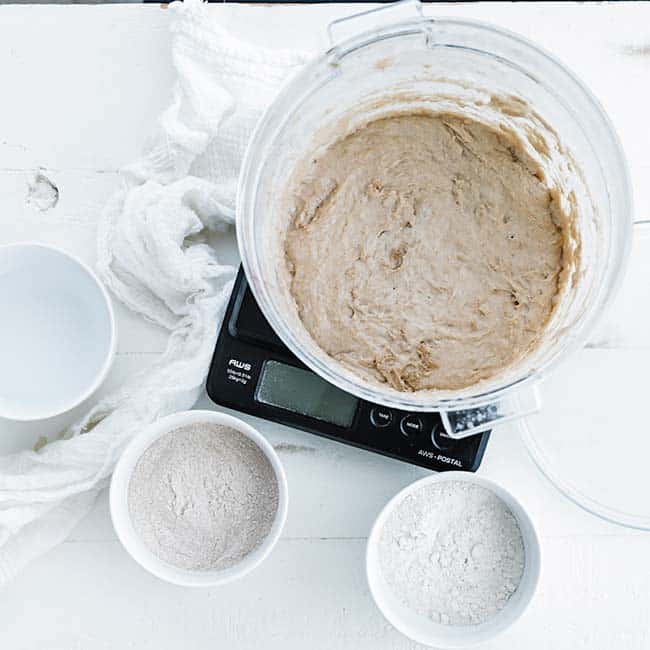
There is no doubt even I feel bloated after consuming lots of bread or can occasionally get a headache. Because of all these important factors, a sourdough starter, or levain, is necessary for all bread baking so let’s get to making it.
What Is a Sourdough Starter (Levain)
A sourdough starter is a natural yeast levain that is used to help bread dough to rise without the use of commercial yeast. It’s the most organic natural way to use in bread dough rising and the benefits from the fermentation process help to break down the gluten as well as providing exceptional flavor.
Since I am feeding the starter the day of mixing the bread dough, it is really a levain because the flavor is not as sour.
Bread Baking Resource: I am a huge fan of the book Flour Water Salt Yeast and highly recommend it. I used several of the methods in that book in my baking and have transformed the way that I know make bread (that is an aff link that allows me to make a few bones off of the sale).
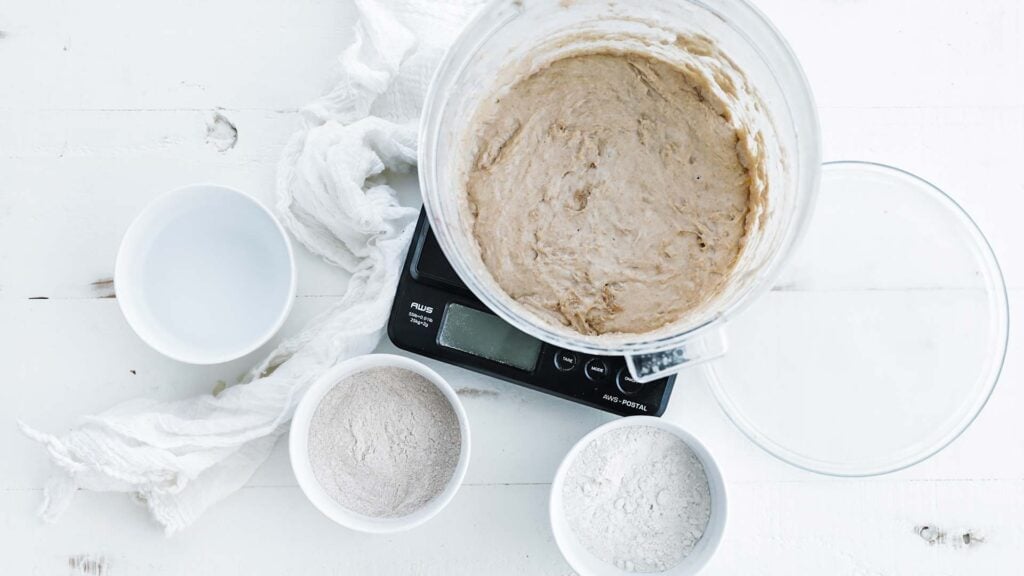
How to Make It
Step 1: Measure out 600 grams of whole wheat flour and transfer it to a large plastic container with a lid. Next, measure out 600 grams of water in between 93° and 95° and pour it into that container and using your hands mix it until just combined. Let the mixture rest uncovered for 2 to 2 ½ hours so that it will collect the natural yeast that is in the air. Cover and put in a warm place between 70° and 90° for 20 to 24 hours. Note: For a wild yeast cover it in cheesecloth and a rubber band and set it outside for that same 2 to 2 ½ hours. N
Step 2: Remove 2/3 to ¾ of the young sourdough starter using the eyeball test and discard. Add 600 grams of whole wheat flour along with 600 grams of water in between 93° and 95° to the remaining young sourdough starter in the plastic container and mix until combined. Let the mixture rest uncovered for 2 to 2 ½ hours so that it will collect the natural yeast that is in the air. Cover and put in a warm place between 70° and 90° for 20 to 24 hours. It should start to have a leathery sour smell to it.
Step 3: You should immediately notice that the mixture has doubled in size. Repeat step 2 in its entirety.
Step 4: The mixture again should be doubled again in size. Discard all but 250 grams of the teenage sourdough starter, as I like to call it at this stage. Add 600 grams of whole wheat flour along with 600 grams of water in between 93° and 95° to the remaining young sourdough starter in the plastic container and mix until combined. Cover and put in a warm place between 70° and 90° for 20 to 24 hours.
Step 5: The mixture at this point most likely hasn’t doubled in size but there should be plenty of air pockets and bubbles in it. The smell should be a bit sour at this stage. Discard all but 200 grams of the mature sourdough starter, which is what it is considered at this point. Add in 480 grams of white flour, 120 grams of whole wheat flour and 480 grams of water that is in between 90° to 92°. Mix until combined, cover, and put in a warm place between 70° and 90° for 20 to 24 hours.
Tools To Make A Sourdough Starter: There are a few important items that you should purchase if you are serious about bread baking, and they are below (those are aff links which allow me to make a few bones off of the sale).
- Thermometer
- Gram Scale
- Container with Lid
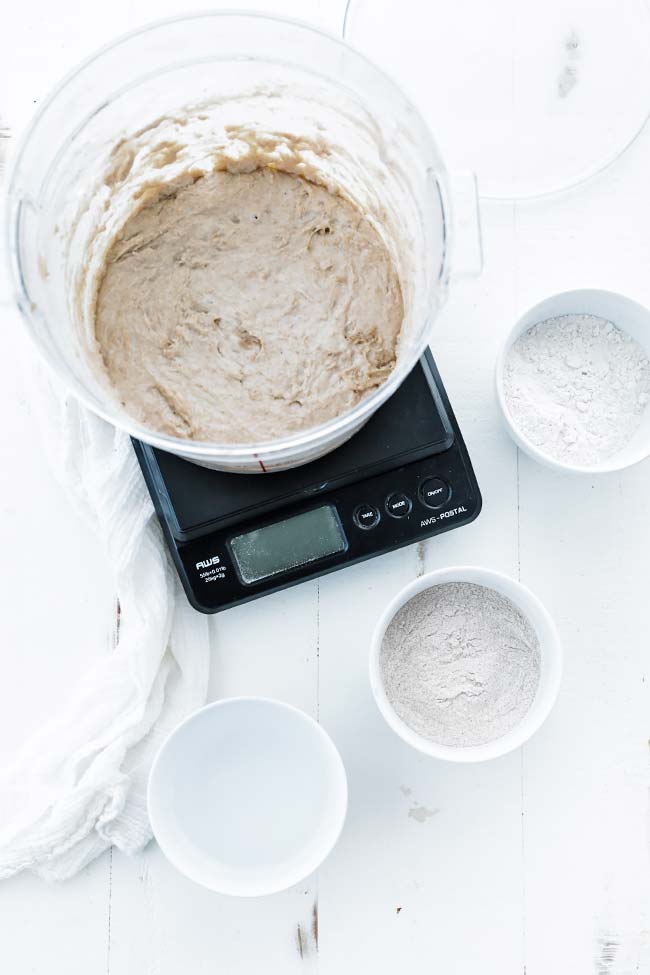
Feeding You Starter
At this point, your levain should be good to go and ready for use. If you bake quite a few times a week, you would want to discard all but 150 grams of mature sourdough starter and replace with 480 grams of white flour, 120 grams of whole wheat flour, and 480 grams of water that is in between 90° to 92° each morning that you are going to bake.
The levain needs to sit in a warm place for 8 to 8 ½ hours before it is good to go and use it in your baking recipe, like in this spelt flour bread recipe. If you use the sourdough starter each morning without discarding and refeeding, you will get a real sourdough bread. I like sourdough but I’m really more into natural levain bread and letting the flour I use in the recipe dough the talking. This part is up to you.
If you are only going to bake like once a week or so then you would want to brush a little water on it, make sure the container is airtight and place it in the refrigerator. Take it out 2 days before you are ready to bake and go through steps 4 through 5 and on into baking your bread.

chef notes + tips
- I made this recipe in the springtime in Chicago which can still be a little chilly. A huge part of making a levain is temperatures. Drop the temperatures on the water a few degrees if you are in the summertime or if you live somewhere where the weather is always warm. Regarding the flour I use, I’m a huge fan of Bob’s Red Mill Flours, always have been.
More Amazing Bread Recipes
- Homemade Pita Bread Recipe
- Homemade White Bread
- Naan
- French Boule with Poolish
- Kamut Flour Bread with Biga
Be sure to follow me on Facebook, Youtube, Instagram, and Pinterest, and if you’ve had a chance to make this then definitely drop me a comment and a rating below!

Video
Sourdough Starter Recipe (Levain)
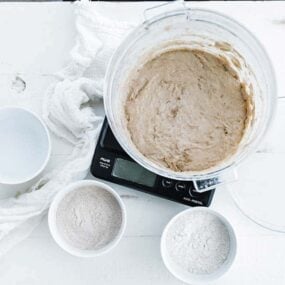
Ingredients
- 2520 grams of whole wheat flour
- 480 grams of white flour
- 2880 grams of warm water (temp specified in directions
Instructions
- In a large plastic container mix together 600 grams of whole wheat flour and 600 grams of water that is 93° to 95° just until combined. Rest uncovered for 2 to 2 ½ hours then cover and keep in a warm place (70° to 90°) for 20 to 24 hours.
- Remove 2/3 to ¾ of the mixture and discard. Add 600 grams of whole wheat flour and 600 grams of water that is 93° to 95° to the young levain and mix just until combined. Rest uncovered for 2 to 2 ½ hours then cover and keep in a warm place (70° to 90°) for 20 to 24 hours.
- Repeat step 2 in its entirety.
- Remove all but 250 grams of the levain and discard. Add 600 grams of whole wheat flour and 600 grams of water that is 93° to 95° to the young levain and mix just until combined. Cover and keep in a warm place (70° to 90°) for 20 to 24 hours.
- Remove all but 150 grams of the levain and discard. Add 480 grams of white flour, 120 grams of whole wheat flour, 480 grams of water that is 90° to 92 and mix until combined. Cover and keep in a warm place (70° to 90°) for 20 to 24 hours and it is ready to use within 8 to 8 1/2 hours.
- Continue feeding every day!

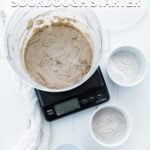
Looking forward to trying this. Can semolina be substituted for the whole wheat either in this starter or in the bread recipe? And how do i proof it in an electric oven in florida? Thank you!
maybe? never heard of that before.
I followed this procedure to make my first ever sourdough starter and it worked fantastically! It’s about a month old now and I’m making beautiful loaves and other delish sourdough foods. Thank you for the easy-to-follow directions!
I followed these easy instructions about 3 1/2 years ago and I am still baking amazing sourdough bread regularly by refrigerating the starter and feeding the starter when it no longer rises well on the day of baking. Billy is the best! I would encourage everyone to try this method of always having amazing fresh sourdough bread and sourdough starter for other recipes like pizza crust, rye, and ciabatta.